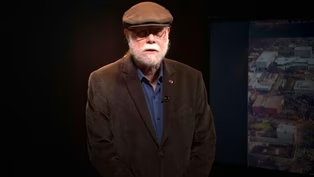
Sancho Sidebar
Clip: Season 2025 Episode 4 | 4m 26sVideo has Closed Captions
Ion Sancho explains ballot undervotes and ballot overvotes in the 2000 presidential election.
Ion Sancho explains ballot undervotes and ballot overvotes in the 2000 Florida presidential election recount. He talks about the proper course of action for county canvassing boards if an overvote occurs and reveals that more than half of the counties in Florida failed to follow the required proceedure.
Problems playing video? | Closed Captioning Feedback
Problems playing video? | Closed Captioning Feedback
WFSU Documentary & Public Affairs is a local public television program presented by WFSU

Sancho Sidebar
Clip: Season 2025 Episode 4 | 4m 26sVideo has Closed Captions
Ion Sancho explains ballot undervotes and ballot overvotes in the 2000 Florida presidential election recount. He talks about the proper course of action for county canvassing boards if an overvote occurs and reveals that more than half of the counties in Florida failed to follow the required proceedure.
Problems playing video? | Closed Captioning Feedback
How to Watch WFSU Documentary & Public Affairs
WFSU Documentary & Public Affairs is available to stream on pbs.org and the free PBS App, available on iPhone, Apple TV, Android TV, Android smartphones, Amazon Fire TV, Amazon Fire Tablet, Roku, Samsung Smart TV, and Vizio.
Providing Support for PBS.org
Learn Moreabout PBS online sponsorship36 of the 67 counties did not know and follow proper Florida law on the issue of an over vote.
I had mentioned earlier that the Supreme Court of Florida had ordered a count of the votes.
Those were the ballots in which no votes were were recorded, but votes might be on them because of the technology.
Well, it turns out that because there was no training of the county judges, a simple error disenfranchized tens of thousands of voters across the state.
And the error was that on the paper ballots, not on the punch cards, on the all the paper ballots at the end of the list of ten candidates was the line write in candidate.
Okay?
A lot of voters who are not very experienced as voters, voted for Bush.
And then in that slot that said write in candidate, they wrote in Bush's name.
Likewise, voters for Gore did the same thing.
They voted for Gore.
Then they go to the bottom.
It says write in candidate.
So they wrote in Gore's name.
Okay, 31 counties counted that properly as okay.
These people made an error.
Florida law has a process in the statute that essentially that ballot has to be duplicated, because all ballots have to be run through the machine to be counted.
So you actually had to take that ballot.
You had a team of individuals that properly.
Then remarked that ballot for Bush or Gore, so that now the machine could read this.
And the reason they did that is because, again, an over vote is when you vote for more legal candidates than the candidates you're allowed to vote for.
If you voted for Bush and wrote in Bush, you didn't vote for more legal candidates than you were supposed to.
You just missed mark your ballot.
So in 31 counties, all of those were properly counted in 36 counties.
They threw all of those voters votes away, even though it was clear if you voted for Bush and wrote in Bush, that's one legal vote.
Those 30, the individuals in 36 counties, they lost their vote in the presidential election through the incompetence of the county canvasing boards.
Again, that's why from 2000 onward, we train the county canvasing boards so they know what an over vote is.
They know what an under vote is.
They know how to properly score whether a vote is illegal or not.
That was probably one of the two great reforms coming out of the 2000 election.
You do have now trained election officials in Florida, and the other great change was we banned technology that, in fact could not legally do a recount for citizens.
And again, this was not just a Florida problem.
Most people in 2000 were not aware that Florida was only the second closest state in the presidential election.
The closest state by percentage was New Mexico.
But New Mexico cast all of its votes on touch screen voting machines.
It is impossible to do a recount on a touchscreen voting machine because they simply aggregate all of people's votes.
So at the final night, there's a number for one candidate and another, number for the other, a recount.
You punch a button, the same number pops out.
You can.
So we today, we know that a recount actually is an individual's vote being able to be read tallied in front of it, witnesses in front of people that will verify that that's what's on the paper.
And, with paper ballots that are hand marked, there is no problem determining the accuracy of an election.
Using properly trained individuals with good standards.
And we have that now in Florida.
But we did not have that in 2000.
Video has Closed Captions
Clip: S2025 Ep4 | 1m 49s | Mickey Adair talks about taking an aireal photo of satellite trucks during the 2000 Florida Recount. (1m 49s)
Providing Support for PBS.org
Learn Moreabout PBS online sponsorshipSupport for PBS provided by:
WFSU Documentary & Public Affairs is a local public television program presented by WFSU














